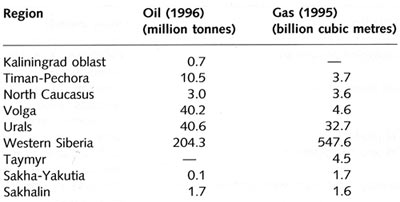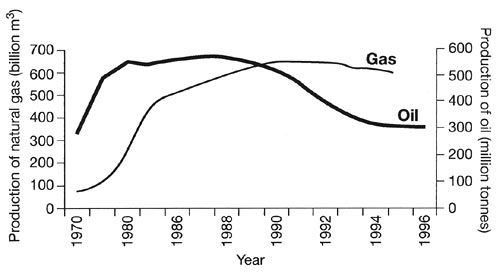Please put an active hyperlink to our site (www.rusnature.info) when you copy the materials from this page
Environmental problems of Northern Eurasia
Environmental Impact of Oil and Gas Development
Oil and Gas Development: Environmental and Social Impacts
<<< Environmental Impact of Oil and Gas
Development: Introduction | Environmental Problems Index | Environmental Impacts of Oil and Gas Production >>>
Hydrocarbon Industries: A Brief Overview
The FSU is currently one of the world's major producers and exporters of oil and gas.
In terms of produced oil, Russia alone ranks third in the world behind Saudi Arabia and
the United States. In 1983, the USSR surpassed the United States to become the world's
largest producer of natural gas and at present Russia remains in first place. Although oil
extraction began on the Apsheron peninsula (Azerbaijan) as early as 1860s, accelerated
development of hydrocarbon resources occurred in the 1970s and 1980s when the FSU
attempted to improve declining rates of economic growth by the expansion of oil and gas
production (Figure 20.2).

Table 20.2 Geographical distribution of oil and gas production across
the Russian Federation
The Tyumen oblast1 in Western Siberia is the most important hydrocarbon producing
province (Table 20.2).

Fig. 20.2 Oil and gas production in the Russian Federation
The Tyumen oblast incorporates two administrative subdivisions: the Khanty-Mansy
Autonomous Okrug (KMAO), the land of two indigenous peoples, Khants and Mansis, and the
Yamal-Nenets Autonomous Okrug (YNAO), the land of Nenets. Most of the oil is found around
the middle course of the Ob in the KMAO, while major gas deposits occur further north in
the YNAO. The production takes place north of 60∞ latitude which predetermines severe
environmental conditions. In the region of Russia's largest gas field, Urengoy, the air
temperature is below -40∞C more than 10 per cent of the time. The whole region is a
swampy lowland underlain by permafrost in the northern taiga and tundra zones.
A rapid growth of production occurred through the 1970s as a result of the discovery
and exploitation of a number of extremely large fields. In 1980, a single giant oil field,
Samotlor, which went into exploitation in 1969, produced 155 million tonnes or one-third
of all cumulative withdrawals (Dienes, 1993; Sagers, 1996). Production focused on large
fields, while a vast stock of smaller fields, which still represented significant
deposits, remained underdeveloped. High-flow reserves provided not less than 95 per cent
of all oil withdrawal (Dienes, 1993). A massive infrastructure had been created in the
region to support this huge production. By the late 1980s, however, as an oil province
Western Siberia had passed its peak (Dienes, 1993). The annual depletion of 'active'
reserves in Western Siberia has more than doubled since the 1970s and the rising
importance of 'hard-to-recover' reserves has led to a sharp increase in low-productivity
wells. Between 1980 and 1991, the number of wells in the province increased by 5.6 times
(Dienes, 1993), (i.e., more drilling and more infrastructure are required per smaller
amount of oil). A rapid decline in reservoir pressure, another aspect of maturing oil
fields, necessitated the use of secondary recovery techniques which required further
investments.
While production costs had been rising through the 1980s due to the physical changes in
oil extraction, in the 1990s high inflation and subsequently higher costs of labour and
equipment supplies drove oil production costs upward. At the same time, oil prices were
fixed by the government below the international level. Under conditions of rising costs
and falling output, investments into maintenance had virtually ceased (Sagers, 1996). A
number of international loans was received by Russia (from the World Bank of
Reconstruction and Development (IBRD), European Bank (EBRD), and other organizations) for
the improvement of the ageing and deteriorating infrastructure; however, these loans have
not been paid in full (Sagers, 1996). While the number of newly discovered large oil
fields is declining, abundant gas resources have been found on the Yamal and Gydan
peninsulas and also offshore in the Barents and Kara Seas (Clarke, 1991; Sagers, 1995) and
development of 40 new gas fields by 2005 is planned. Not only does Russia have enormous
reserves of gas, but these reserves are also characterized by an extremely high degree of
concentration; in the 1990s just six fields accounted for 93 per cent of total gas
production (Sagers, 1995). A decline in gas production, which has been observed through
the 1990s, was associated with ongoing economic reforms while resources were not a
constraining factor. High domestic consumption of gas and its increasing role as a major
fuel used for power generation ensured that the decrease in gas production was small in
comparison with general industrial decline. Despite the problems faced by the hydrocarbon
industries in the 1990s, a long-term programme for exploitation of hydrocarbon resources
in the north has been proposed which includes development of the offshore resources in the
Arctic Ocean.
This brief overview of oil and gas development in the Russian north highlights the
origin of environmental problems associated with production of hydrocarbons: (I)
industrial output at the maximum level, in the shortest possible time and regardless of
any (including environmental) costs during the Soviet period when rapid growth was
achieved through extensive development rather than efficient use of resources; (II)
collapse of the economy and acute underfunding in the post-Soviet time which account for
the aged and dilapidated infrastructure which is prone to accidents and a high rate of
waste. The same factors are responsible for the poor environmental quality in other oil-
and gas-producing regions: the Caspian region which is the oldest oil-producing area with
a history dating back to the 1860s, the Volga-Urals province, Timan-Pechora basin,
Sakhalin, Turkmenistan, and Kazakhstan. In the north, however, a massive scale of
production, remoteness of the area, and unfavourable natural conditions have resulted in
the state of environment which can be only described as critical.
<<< Environmental Impact of Oil and Gas
Development: Introduction | Environmental Problems Index | Environmental Impacts of Oil and Gas Production >>>
Contents of the Environmental Impact of Oil
and Gas Development section:
Other sections of Environmental Problems of Nortern Eurasia:
|
|